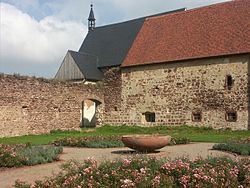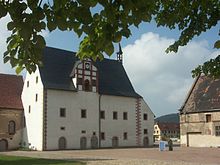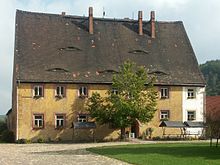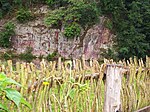Monastery book
| Cistercian monastery book | |
|---|---|
 Area of the former cloister |
|
| location |
Saxony |
| Coordinates: | 51 ° 9 '7.9 " N , 12 ° 59' 12.7" E |
| Serial number according to Janauschek |
503 |
| Patronage | St. Mary |
| founding year | 1192 |
| Year of dissolution / annulment |
1525 |
| Mother monastery | Sittichenbach Monastery |
| Primary Abbey | Morimond Monastery |
The Buch monastery is a former Saxon Cistercian monastery that was founded as the " St. Marien " monastery in the 12th century and is now located in the Klosterbuch district of the city of Leisnig . After the Reformation, it and its lands became a purely agricultural operation. Today, under the leadership of the Förderverein Kloster Buch e. V. preserved the monastery complex according to its historical roots, restored it and made it accessible to visitors.
location
Buch monastery is located near Leisnig in the district of central Saxony at the knee of the Freiberger Mulde . It belongs to the Leisnig district of Klosterbuch and is about 4 km to the east from Leisnig city center. In the area of the monastery, the river created an approximately 800 m wide flood plain, which is used for agriculture and its slopes are lined with forests. The Mulde flows between the monastery area and the rocky steep bank opposite
history
From the foundation to the Reformation
A founding document for the Buch monastery has not survived. On the occasion of the assurance that the parish of Leisnig would be transferred to the monastery, it is stated in a certificate from Emperor Heinrich VI. First mentioned in 1192. According to the Cistercian tradition, Abbot Hildebert had left Sittichenbach with twelve monks and twelve converses from the Cistercian monastery Sittichenbach near Eisleben on August 10, 1192 and moved into Buch on August 17 of the same year. This makes Buch a subsidiary of Sittichenbach.
Buch monastery was under the rule of the Burgraves of Leisnig , who had their seat at Mildenstein Castle in Leisnig, only a few kilometers away . From Burgrave Heinrich III. the initiative to found the monastery came out. Buch monastery was not founded in an unpopulated area, as should ideally be the case with a Cistercian monastery.
The monastery was planned generously. Today the 70 m long chapter house still shows that a large convent was expected. How many monks and conversations actually lived in the monastery is unknown today. After all, it is known that at least in the late Middle Ages the monks were mostly of bourgeois origin and came from the area. Halle (Saale) is the most distant city that is documented as the place of origin of a monk.
In the course of time, the monastery received further donations in addition to the founding property of the Burgrave of Leisnig. After all, it had properties in 52 villages. Grangien (farmhouses) existed in Paudritzsch , Altenhof , Beiersdorf , Poselitz, Tautendorf (with sheep farm) as well as in Ammelgoßwitz near Belgern and Unterlödla near Altenburg , temporarily also in other places. From 1309 the monastery owned the city of Belgern including the Elbe ferry. The monastery also owned courtyards in Oschatz and Leipzig. This possession can be taken as an indication of a participation of the monks in the late medieval trade.
The Margraves of Meissen had repeatedly given donations to the monastery or given donations from their ministerials to the monastery. After a dispute between the Burgraves of Leisnig and the monastery in 1365, the Margraves forced the Burgraves of Leisnig to sell the Burgraviate, which was incorporated into the Margraviate as castrum . In 1433, shortly before the invention of printing , another handwritten Bible was created in the Buch monastery .
In 1441, the abbot of Buch received privileges that were usually reserved for bishops: he was allowed to consecrate objects that were intended for worship and was given the right to wear the miter and the episcopal ring at high mass . In the same year the monastery was awarded a coat of arms by the Basel Council . It shows the Lamb of God with the flag of the cross, the symbol of victory over death in the resurrection. Three rose petals symbolize Mary , the patron saint of all Cistercian monasteries. In the town of Belgern, which belongs to the monastery, a Cistercian religious school was established in 1486. Here young monks were prepared for their studies, especially for attending the Cistercian preparatory college at Leipzig University.
After the Reformation
When Abbot Antonius Dytz died on December 20, 1525, the monastery was dissolved in the course of the Reformation . In neighboring Leisnig, the Lutheran doctrine had already established itself at this time. Elector Johann the Steadfast had the upcoming election of abbot prevented by two of his officials and placed the administration of the monastery property under his representative, Kaspar Kitzscher. The monks still living in the monastery received parts of the monastery property for their livelihood or money for a handicraft, depending on their rank. They could also stay in the monastery.
The goods of the monastery were initially administered by representatives of the Leisnig bailiff. From 1532 the estates took over the administration of all sequestered monastery estates. Distant possessions were lost. There was also a gradual sale (Poselitz 1534, Paudritzsch 1545). In 1548 the property was assigned to the monastery office book and an office inheritance book was created. From 1556 the administration was carried out by electoral councils. In 1567, the monastery property was finally given to Johann von Zeschau as a hereditary fiefdom and gained the status of a manor. The abbot's house was rebuilt by this family and the manor church was built around 1600 from the ruins of the choir of the monastery church. It was so damaged by the Thirty Years War that it had to be auctioned. It was auctioned by the Princely School Grimma, whose ownership it remained as a state school property. In 1678 the chapel was consecrated again after renovation. The Landesschule Grimma managed the remaining monastery property (including court rights) until 1836, when it became a Saxon state domain . Tenants kept the business going in Buch.
After 1945 the property was converted into a state-owned property as part of the land reform . The successor to this manor, " August Bebel ", was a civil law company after 1990 , which, however, gave up the agricultural use of the monastery in 1994.
Monastery book today
From 1992, the city of Leisnig and the Leisnig History and Local History Association directed the first safety and restoration work. Guided tours through the old facility took place on the weekends. In 2000 the monastery complex became the property of the Förderverein Kloster Buch e. V. This began the transformation into a cultural and historical center.
The flood events in the Mulde in August 2002 caused enormous damage to the monastery complex, which could be completely repaired by 2008.
Today there are exhibitions, events and guided tours in the monastery. Visitor magnets are the monthly farmers' markets and the monastery and harvest festival in September. Tens of thousands of visitors come to the monastery every year.
The buildings
From the medieval monastery buildings, the eastern parts of the church, the chapter house , the infirmary , the abbey and several outbuildings have been preserved to this day.
Of the medieval three-aisled pillar basilica with transept , only an outer wall of the nave , the choir and three side chapels still exist today . In the choir, a smaller Protestant church (named Gutskirche) was built in 1678 using medieval components (columns, vaults, windows) from the church and the enclosure , but now with the altar facing west and not recognizable as a church from the current monastery courtyard.
The 70 m long chapter house is the largest surviving medieval building. The room layout was changed several times due to later use. What is certain is that it contained the chapter house as a meeting room and that the entire upper floor was previously used as a dormitory (bedroom). The Necessarium was located at the southern end of the chapter house . This was a toilet facility that was traversed by a trough branch and was only accessible from the inside of the dormitory. Remnants of the lower part of the Necessarium can still be viewed.
The (two-storey 1400 dendrochronologically detected in the roof truss) as a house built of Abbot Abthaus , it is determined in external appearance of the tags in the 16th and 17th centuries. The pointed arch portal dates from the Middle Ages.
The eastern part of the hospital room and the chapel still exist from the former infirmary behind the abbey . Infirmaries and necessaries are only preserved in a few monasteries.
The remains of the former Necessarium
To the west of the former enclosure there are ruins of the so-called brewing or malt house . They are parts of the former lay or conversational area of the monastery. Here guests were also received and travelers accommodated. On the way to the brewery you pass the area of the former cloister , the location of which is indicated by means of flower beds. Between the chapter house and the brewery, a 100 m long section of the monastery wall has been preserved, which formerly surrounded the entire complex.
In the farm buildings from the time of the monastery as a farm estate of the monastery shop, a demonstration workshop and spaces with special offers today are housed for children. Behind the farm buildings there is a herb garden facing the Mulde .
literature
- Herta Battré: Contributions to the history of the monastery book. Dissertation, Leipzig 1951 , verwaltungsportal.de (PDF; 253 kB).
- Michael Beyer: The dissolution of the Buch monastery near Leisnig during the Reformation. in: Sächsische Heimatblätter 2/2017, pp. 104–108
- Friedrich Gentzsch: Kloster Buch - An approach to its history based on the documents. Sax-Verlag, Leipzig / Beucha 2014, ISBN 978-3-86729-131-6
- Steffen Delang, Franziska Koch, Heinrich Magirius , Thomas Schmidt: The Cistercian monastery book. Construction research work report. In: Workbook of the State Office for Monument Preservation Saxony , 9, Sax-Verlag, Beucha 2006, ISBN 978-3-934544-85-7
- Carl Wilhelm Hingst : The monastery book in its origin, growth and luster. In: Mittheilungen of the Royal Saxon Association for Research and Preservation of Patriotic Historical and Art Monuments , Issue 14, Dresden 1865, pp. 64–90
- Leisniger Geschichts- und Heimatverein e. V. (Ed.), Förderverein Kloster Buch e. V. (Ed.): Former Cistercian monastery book. Leisnig 2003
Web links
- Kloster Buch in the Digital Historical Directory of Saxony
- Literature about monastery book in the Saxon Bibliography
- Website of the Förderverein Kloster Buch e. V.
- Website of the half-timbered monastery book
Individual evidence
- ↑ Original document: SHStA Dresden: 10001; Older documents: No. 101 from December 1, 1192.
- ↑ P. Leopoldus Janauschek: Originum Cisterciensium Tomus Primus in quo praemissis congregationum domiciliis adjectisque tabulis chronologico-genealogicis veterum abbatiarum a monachis habitatarum fundationes ad fidem antiquissimorum fontium primus descripsit . Vindobonae 1877 (reprinted by Ridgewood, NJ, Gregg Press, 1964) urn : nbn: de: urmel-f25cef6f-4481-4aba-ab64-7ad9232744c71-00001101-0048
- ↑ Johann Kamprad: Leisnigker Chronica of 1753, reprinted by order of the Leisniger history and heritage association 2013, p 316
- ^ Kurt Schwabe : The archives of the Princely and State School St. Augustin zu Grimma and its fate after 1945 . In: Friedrich Wermuth, Karl Irmscher u. a .: From the electoral state school to the St. Augustin high school in Grimma 1550–2000 . Beucha 2000, ISBN 3-930076-99-3 , p. 151.











